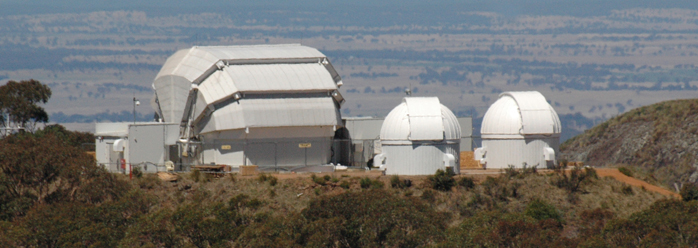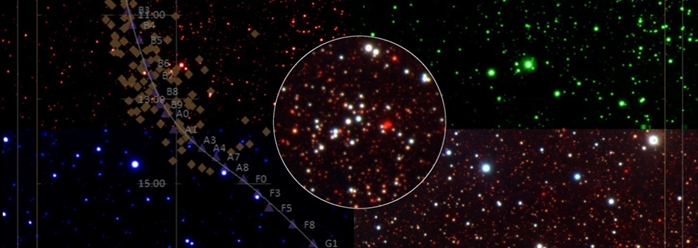Our Solar Siblings is an evidence based, curriculum-based, project for high school level astronomy. The current focus of the materials is primarily around Year 9 and 10 (The Curriculum Map for the Australian Curriculum is available here) . Use in Year 11 and 12 is also possible if the the extension topics in the curriculum materials are used. These can also form the basis of independent research projects in Year 10 and beyond. Use in Year 7 and 8 is possible, especially for the first and second parts (the ‘pretty picture’ section), but we would suggest that most of the material in the third part may be above their level. We provide teaching and learning support, access to research grade telescope instrumentation in the classroom and curriculum materials to teachers who would like an opportunity to undertake authentic astronomy in their classrooms with a minimum of stress and preparation. The core of the project revolves around the curriculum materials which are constantly updated, expanded and bug-fixed as teachers implement the project in their classrooms term by term, year by year. An introduction is provided in the video below and the latest introductory document for curriculum set is available from here.
The focus of Our Solar Siblings is upon stars; how they are born, how they live and how they come to die. Truly from dust to dust and ashes to ashes, stars are born from great interstellar clouds of dust and gas and eventually return much of this material, transformed into heavier elements through the processes of nuclear fusion in the cores of stars, back to the interstellar medium to give birth to new stars and thus continue the cycle. It is from this enriched dust that all of the heavy elements are sourced to form the planets as well as the building blocks of life. As Carl Sagan put it, we are all made of stardust.There are other, arguably more important, phenomena in the cosmos, such as Dark Matter and Dark Energy which have a much greater impact on the large scale structure, motion and evolution of the universe (we explore these in detail too!). It is the Sun and her sibling stars, however, and their continual cyclical production of light and higher elements that is most connected to, and most fundamental to the creation and support of our direct human experience of the cosmos.
 (Image Credit: http://lcogt.net//image/earth/siding-spring-observatory-expands )
(Image Credit: http://lcogt.net//image/earth/siding-spring-observatory-expands )
The design of Our Solar Siblings is currently in three parts and is structured around curriculum materials written by Michael Fitzgerald and David McKinnon. The first part, entitled “Telescopes, the Night Sky and the Cosmos”, introduces students to the Las Cumbres Observatory ( LCOGT ) telescopes they will access in this project; why telescopes are actually useful; and, allow them to select objects they will image using the telescopes. The selection of objects for imaging is purposely skewed towards the aesthetically pleasing aspects of the cosmos, but is embedded in a broad brush exploration of the contents of the universe from galaxy clusters through individual galaxies to objects within our own galaxy. The selection of objects during this class will form the basis of a live telescope session where students can, in their classrooms, watch their images being collected by one of the LCOGT telescopes halfway around the world.
The second part, entitled “Understanding the Universe through Colour and Brightness”, allows student to take their images from the telescopes (as well as provided archival ‘practice’ images) and create their own colour images from the scientific black and white images taken through different filters in the same manner as a professional astronomer. In so doing, they begin a process towards understanding the fundamentals of astronomical imaging that provides scaffolding for deeper scientific explorations of astronomical images in the third project. While exploring the images, students can experience how relatively simple observations of colour can provide us with a wealth of information about objects that would simply be impossible to explore via any other method. These qualitative colour-based interpretative skills are used to expand the understanding about the objects explored briefly in the first part. The students then learn about the colour, brightness, size and shape of galaxies in the form of creating their own Hubble Tuning Fork diagram. We then explore Supernovae in distant galaxies to understand the big bang, dark energy and calculate the age of the Universe. The students further expand their understanding by exploring galaxy rotation, dark matter and how galaxies are distributed across the universe.
The third part, entitled “Uncovering the Nature and Lives of Stars”, the focus is finally turned towards Our Solar Siblings; stars. This part builds upon the skills and content knowledge built up in the first two parts to explore the general properties and lifecycles of stars that form the core of the stardust cycle. Students are first introduced to the primary diagram used in the analysis of stars, the Hertszprung-Russell (HR) Diagram, through pattern-matching games with supplied colour images before building their own diagrams from the images from the LCOGT research grade telescopes using tools and techniques that professional astronomers use. Students move through stages of understanding the distances, sizes, ages and lifecycle of stars by comparing their own measurements, results and analysis to work of other scientists. The length and breadth of this experience is chosen by the teacher and can vary from a light skim of the concepts over a few class periods to a term-long or even year-long exploration.
Currently, the curriculum material is not available to anonymous users and is copyrighted, however use of the material is generally encouraged by teachers and educators with knowledge and permission. To access the material, please email Michael Fitzgerald to request the download link or purchase a USB stick containing the material from the Shop. We also provide a remix of an open source textbook that complements our material as well. Also please consider signing up for the mailing list to keep up-to-date with Our Solar Siblings developments!

